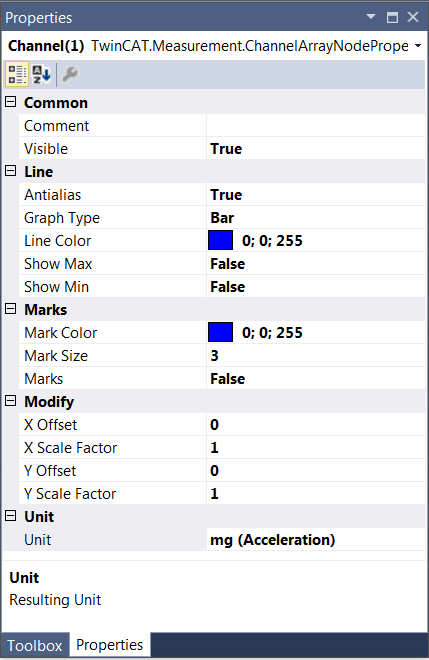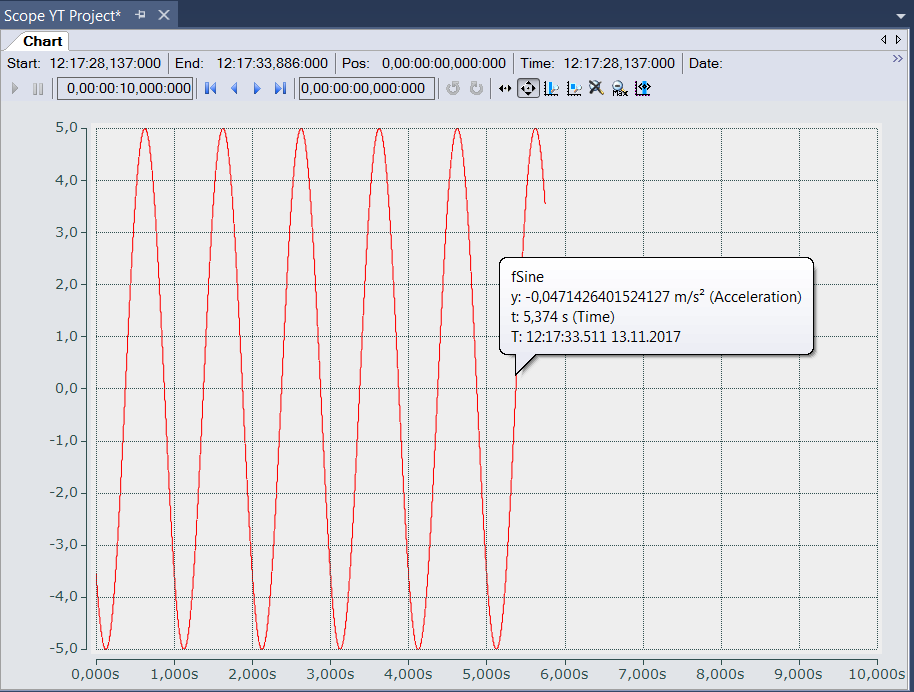Introduction
Base units
The units in TC3 Scope are based on the SI system of units. Both the seven standard SI units and all units that can be derived from the product of any powers of these seven standard SI units are designated base units. These base units are coded in TC3 Scope via unique Enum values. To do this, four bits are interpreted as a signed value for each power value of the base units and combined to form a 32-bit integer (Int32), so that any derived units (limited only by the size of the data type) can be formed. Each digit of the Enum value represents one of the base units so that a unit is formed from the following equation in the case of an Enum value of "0xabcdefgh":
E = Anglea * Luminous Intesityb * Amount of Substancec * Temperatured * Currente * Timef * Massg * Length h
The following table shows the basic values for the calculation of the derived units.
Measured variable | Name of the unit | Symbol of the unit | Enum value |
|---|---|---|---|
Dimensionless values | Unit of One | 1 | 0x00000000 |
Length | Meter | m | 0x00000001 |
Mass | Kilogram | kg | 0x00000010 |
Time | Second | s | 0x00000100 |
Current | Ampere | A | 0x00001000 |
Temperature | Degree Celsius | °C | 0x00010000 |
Amount of Substance | Mole | mol | 0x00100000 |
Luminous Intensity | Candela | cd | 0x01000000 |
Angle | Radian | rad | 0x10000000 |
In addition to the seven standard SI units, two further units are listed here that are relevant for practical use. One of them is the "Unit of One" for dimensionless variables, which also serves as the default value if no other unit has been set. On the other hand, the angle is also considered, since there are several units such as the angular velocity or the solid angle that are composed of the powers of the angle, even though the angle is actually dimensionless. A further peculiarity is mass with its SI unit of kilogram, because unlike the other SI units it already contains a prefix in its basic form. Therefore, in order to be able to carry out scaling with the aid of prefixes, gram is assumed as the unit of mass in TC3 Scope View instead of kilogram. For the derived units, however, the mass percentage is nevertheless represented as kilograms, as the definition would otherwise no longer fit.
In order to form units derived from these basic values, the powers of the standard SI units must be multiplied accordingly. For example, if a force is to be illustrated in Newton, the rule is: N = m1 * kg1 * s-2, resulting in an Enum value of 0x00000E11. E represents the power of "-2" here, which results from the display as two's complement in the hexadecimal system. All the derived base units already predefined in TC3 Scope are listed below.
Measured variable | Name of the unit | Symbol of the unit | Enum value |
|---|---|---|---|
Absorbed Dose | Gray | Gy | 0x00000E02 |
Acceleration | Meter per square second | m * s-2 | 0x00000E01 |
Angular Acceleration | Radian per square second | rad * s-2 | 0x10000E00 |
Angular Velocity | Radian per second | rad * s-1 | 0x10000F00 |
Area | Square meter | m2 | 0x00000002 |
Capacity | Farad | F | 0x000024FE, |
Catalytic Activity | Katal | kat | 0x00100F000 |
Charge | Coulomb | C | 0x00001100 |
Conductance | Siemens | S | 0x000023FE |
Energy | Joule | J | 0x00000E12 |
Force | Newton | N | 0x00000E11 |
Frequency | Hertz | Hz | 0x00000F00 |
Illuminance | Lux | lx | 0x0100000E |
Inductance | Henry | H | 0x0000EE12 |
Luminous Flux | Lumen | lm | 0x21000000 |
Magnetic Flux | Weber | Wb | 0x0000FE12 |
Magnetic Flux Density | Tesla | T | 0x0000FE10 |
Power | Watt | W | 0x00000D12 |
Pressure | Pascal | Pa | 0x00000E1F |
Resistance | Ohm | Ω | 0x0000ED12 |
Solid Angle | Steradian | sr | 0x20000000 |
Velocity | Meter per second | m * s-1 | 0x00000F01 |
Voltage | Volt | V | 0x0000FD12 |
Volume | Cubic meter | m3 | 0x00000003 |
Any other base units can be formed by means of the Enum values (see also Configuration of units with the aid of PLC attributes).
However, the specification of the base unit is insufficient in order to represent a unit completely and to scale the measured values in a suitable manner afterwards. Therefore, further parameters need to be specified: a scaling factor, an offset and a prefix. The scaling factor and the offset are used to convert the raw values into the appropriate unit. The prefix offers the option to scale a unit by the power of ten. The following prefixes are available. For example, if "milli" is selected as the prefix, the respective unit is divided by 10-3 so that automatic adjustment of the scaling takes place.
Name of the prefix | Symbol of the prefix | Multiplication factor | Enum value |
|---|---|---|---|
Yocto | y | 10-24 | -24 |
Zepto | z | 10-21 | -21 |
Atto | a | 10-18 | -18 |
Femto | f | 10-15 | -15 |
Pico | p | 10-12 | -12 |
Nano | n | 10-9 | -9 |
Micro | µ | 10-6 | -6 |
Milli | m | 10-3 | -3 |
Centi | c | 10-2 | -2 |
Deci | d | 10-1 | -1 |
None | - | 100 | 0 |
Deca | da | 101 | 1 |
Hecto | h | 102 | 2 |
Kilo | k | 103 | 3 |
Mega | M | 106 | 6 |
Giga | G | 109 | 9 |
Tera | T | 1012 | 12 |
Peta | P | 1015 | 15 |
Exa | E | 1018 | 18 |
Zetta | Z | 1021 | 21 |
Yotta | Y | 1024 | 24 |
Transformations
In the measurement technology application area, it is frequently the case that an SI unit has to be converted into another SI unit. This is the case, for example, when an acceleration is measured with the aid of a sensor and a fieldbus terminal. Voltages or currents are initially measured, which should give an indication of the acceleration. For this reason, the TC3 Scope also provides for the transformation from one SI unit into another SI unit. Such a transformation is defined by a source variable (source unit), a target variable (target unit), a scaling factor for the conversion and a name.
Example:
- Source variable: Voltage
- Target variable: Acceleration
- Scaling factor: 0.101937
- Name: Accelerometer
User units
In addition to the SI system of units there are further systems of units that are also used in practice (CGS system of units, Anglo-American system of measurement, etc.). In order to be able to represent such units too, the TC3 Scope provides for so-called user units into which the base units can be converted. A user unit is defined through its associated basic variable, the name and the symbol of the user unit, a scaling factor and an offset for conversion as well as a prefix. For the user unit gravitation (g), for example, this results in the following values:
- Basic variable: Acceleration
- Name: Gravity
- Symbol: g
- Scaling factor: 1 / 9.81
- Offset: 0
- Prefix: none
Resulting unit
A unit in the TC3 Scope can thus be composed of the three elements base unit, transformation and user unit, depending on what is required in the specific application case. However, it is always the resulting unit that is displayed. If a voltage is the basic variable, which is then converted via a transformation into an acceleration in m/s2 and from there into g with the aid of a user unit, the measured data and offset with the scaling factors and offsets and the result is the acceleration in g.
The following illustration shows how the resulting unit is displayed in the Properties window:

If existent, the symbol for the prefix will be displayed first. After that comes the symbol for the unit and subsequently the measured variable in brackets. Apart from the display in the Properties window, the units also appear in the tooltips that appear when clicking on a data point (see illustration) and are displayed in the marker window.
